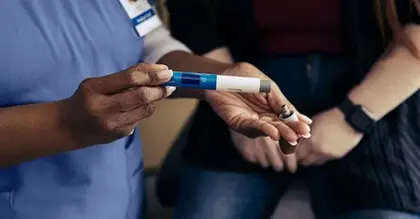Note: This document contains side effect information about nitrofurantoin. Some dosage forms listed on this page may not apply to the brand name Macrobid.
Applies to nitrofurantoin: oral capsules, oral suspension.
Side effects include:
GI effects (nausea, flatulence, vomiting, anorexia, diarrhea, dyspepsia, constipation, abdominal pain); headache; brown discoloration of urine.
For Healthcare Professionals
Applies to nitrofurantoin: compounding powder, oral capsule, oral suspension.
Gastrointestinal
Nausea, emesis, and anorexia occurred most often; abdominal pain and diarrhea were less common. These side effects were dose-related and have been minimized by dose reduction. Many patients who could not tolerate the microcrystalline formulation were able to take the macrocrystals formulation without nausea.
The onset of pseudomembranous colitis symptoms has been reported during or after antimicrobial therapy.[Ref]
Common (1% to 10%): Nausea, emesis, flatulence
Uncommon (0.1% to 1%): Abdominal pain, diarrhea
Frequency not reported: Dyspepsia, constipation, sialadenitis, pancreatitis, pseudomembranous colitis, Clostridioides difficile-associated diarrhea, parotitis[Ref]
Metabolic
Common (1% to 10%): Anorexia
Frequency not reported: Acute porphyria, false positive urinary glucose[Ref]
Nervous system
Common (1% to 10%): Headache
Rare (0.01% to 0.1%): Peripheral neuropathy including optic neuritis (sensory and motor involvement), nystagmus, vertigo, dizziness, drowsiness
Frequency not reported: Benign intracranial hypertension (pseudotumor cerebri), bulging fontanels, polyneuropathy (including optic neuritis), sensory loss, paresthesia, motor loss, neuropathy (generally beginning as paresthesia of the lower extremities and the hands and progressing to muscle weakness and wasting), cerebellar dysfunction
Postmarketing reports: Optic neuritis[Ref]
Peripheral neuropathy (which was sometimes severe or irreversible) has occurred; fatalities have been reported. Risk of peripheral neuropathy has been increased with renal dysfunction (CrCl less than 60 mL/min or clinically significant elevated serum creatinine), anemia, vitamin B deficiency, diabetes mellitus, electrolyte imbalance, and debilitating disease.
Polyneuropathy, which started peripherally with initial sensory loss and paresthesia but progressed to motor loss (often with severe muscle atrophy), has occurred during therapy. A predisposing condition in most of these patients was renal failure, which was often accompanied by anemia, diabetes, electrolyte imbalance, vitamin B deficiency, and debilitating disease. After stopping this drug, further deterioration generally halted and total or partial regression occurred in almost 80% of affected patients. These reactions were sometime severe or irreversible but were rarely fatal.[Ref]
Hematologic
Common (1% to 10%): Eosinophilia, decreased hemoglobin
Rare (0.01% to 0.1%): Aplastic anemia
Frequency not reported: Hemolytic anemia, leukopenia, agranulocytosis, granulocytopenia, megaloblastic anemia, glucose-6-phosphate dehydrogenase deficiency anemia, thrombocytopenia, cyanosis secondary to methemoglobinemia[Ref]
Hepatic
Common (1% to 10%): Elevated AST, elevated ALT
Rare (0.01% to 0.1%): Liver failure (may be fatal), cholestatic jaundice, chronic active hepatitis (including fatalities)
Frequency not reported: Hepatic necrosis, autoimmune hepatitis, hepatic reactions (including hepatitis, cholestatic jaundice, chronic active hepatitis, hepatic necrosis), hepatotoxicity with concurrent pulmonary reactions, elevated bilirubin, hepatic toxicity (presented with jaundice, abdominal pain, malaise, nausea, anorexia)[Ref]
Other
Common (1% to 10%): Increased serum phosphorus/phosphate
Frequency not reported: Fever, chills, malaise, asthenia, drug fever, superinfections due to resistant organisms (e.g., Pseudomonas species, Candida species), C difficile superinfections, increased alkaline phosphatase, increased lactate dehydrogenase[Ref]
Respiratory
Chronic pulmonary reactions occurred rarely, generally in patients who received continuous therapy for at least 6 months; such reactions were more common in elderly patients.
Acute pulmonary reactions generally occurred within the first week of therapy and were reversible when therapy was stopped; resolution was often dramatic. Acute pulmonary reactions were commonly manifested by fever, chills, cough, chest pain, dyspnea, pulmonary infiltration with consolidation/pleural effusion on chest x-ray, and eosinophilia.
In subacute pulmonary reactions, fever and eosinophilia occurred less often than in the acute form. After therapy was stopped, recovery sometimes required several months.[Ref]
Rare (0.01% to 0.1%): Chronic pulmonary reactions (symptoms included malaise, exertional dyspnea, cough, altered pulmonary function, radiologic/histologic findings of diffuse interstitial pneumonitis and/or fibrosis)
Frequency not reported: Acute pulmonary reactions (symptoms included fever, chills, cough, chest pain, dyspnea, pulmonary infiltration with consolidation/pleural effusion on chest x-ray, eosinophilia), subacute pulmonary reactions, chronic/subacute/acute pulmonary hypersensitivity reactions, cough, dyspnea, permanent impairment of pulmonary function, pulmonary fibrosis, bronchiolitis obliterans organizing pneumonia, asthma attacks (in patients with history of asthma), pulmonary infiltration with consolidation/pleural effusion on x-ray[Ref]
Cardiovascular
Changes in ECG (e.g., nonspecific ST/T wave changes, bundle branch block) have occurred, associated with pulmonary reactions; vasculitis was sometimes associated with pulmonary reactions.[Ref]
Rare (0.01% to 0.1%): Collapse, cyanosis, changes in ECG (e.g., nonspecific ST/T wave changes, bundle branch block)
Frequency not reported: Vasculitis, cardiopulmonary failure (leading to collapse and death), chest pain[Ref]
Dermatologic
Rare (0.01% to 0.1%): Exfoliative dermatitis, erythema multiforme (including Stevens-Johnson syndrome)
Frequency not reported: Pruritus, urticaria, allergic skin reactions, alopecia/transient alopecia, angioedema/angioneurotic edema, cutaneous vasculitis, maculopapular eruptions, erythematous eruptions, eczematous eruptions, rash, drug rash with eosinophilia and systemic symptoms (DRESS) syndrome[Ref]
Psychiatric
Rare (0.01% to 0.1%): Depression, euphoria, confusion, psychotic reactions[Ref]
Hypersensitivity
Hypersensitivity reactions were the most frequently reported side effect during postmarketing experience.[Ref]
Frequency not reported: Anaphylaxis
Postmarketing reports: Hypersensitivity reactions[Ref]
Musculoskeletal
Lupus-like syndrome has been associated with pulmonary reaction.
Frequency not reported: Lupus-like syndrome/lupus erythematous-like syndrome, arthralgia, myalgia, muscle atrophy, increased creatine phosphokinase
Renal
Frequency not reported: Interstitial nephritis[Ref]
Genitourinary
Frequency not reported: Yellow or brown discoloration of urine, genitourinary tract superinfections (by fungi or resistant organisms [e.g., Pseudomonas, Candida]), dark colored urine[Ref]
Ocular
Frequency not reported: Amblyopia, retinopathy (due to intraretinal crystals), diplopia[Ref]




